
While the Chronicles of Narnia series has enthralled its readers for several generations, Professor Michael Ward of the University of Oxford contends that many have glossed over its deeper meaning.
Following his convocation address in Christ Chapel on Nov. 14, earlier that morning, Ward gave a lecture titled “Great Balls of Fire: C.S. Lewis, Narnia, and the Planets” in Lane Hall. A senior research fellow at the University of Oxford and a professor of apologetics at Houston Baptist University, Ward has studied C.S. Lewis expansively. His work includes authoring a book called “Planet Narnia: The Seven Heavens and the Imagination of C.S. Lewis” and serving as an editor for “The Cambridge Companion to C.S. Lewis and C.S. Lewis at Poets’ Corner.”
Ward started his lecture by asking the audience who had read at least one book from the Chronicles of Narnia. Although everyone raised a hand, Ward demonstrated that most did not know the reasoning behind C.S. Lewis’s famous work.
“If we are apt to call Narnia a hodge-podge,” Ward stated, “we should look again.”
Ward stated that the Chronicles of Narnia might just appear as a collection of stories with a mix of different settings, thereby reducing its worth to a great piece of literature.
“Scholars say they are just for the children,” Ward said.
For years, academics have sought the series’ underlying meaning, including what each of the seven books could symbolize. Theories range from the seven deadly sins to the seven books of the Faerie Queen. There have been disagreements among scholars, however, and no clear answer has been reached.
Ward believes that the seven books of the Narnia series represent the seven planets of the medieval universe: Jupiter, Saturn, the Moon, the Sun, Mercury, Venus, and Mars.
He gave four reasons to support his claim: Lewis’s secretive nature, his belief in Colossians 1:16-17, the “Kappa Element in Romane” or the hidden elements in stories, and transferred classicism, a literary device that exploits paganism for Christian purposes.
Ward presented evidence for his theory from each of the books. For example, he claimed the Voyage of the Dawn Treader is the sun story. During the book, the characters move closer and closer to the sun and the dawn. The theme of dragons in the book, according to Ward, makes sense because the sun and light god, Apollo, is known as the dragon-slayer in Greek mythology. Aslan, the Christ figure, is seen shining in the sunlight, demonstrating how he is the true and better Apollo and the light of the world.
“It could be used as an imaginative blueprint to provide atmosphere for the book,” Ward said.
He insisted that this system provides a palate on which Lewis cast his Christian message of a Christian God and Jesus Christ as greater than all the gods represented by the planets.
Sophomore Abraham Sullivan, who was previously familiar with Ward’s book, was convinced of the argument’s validity after the lecture.
“I like how he revealed his theory to us as he discovered it himself,” Sullivan said. “His demonstration on the screen proved it to me.”
Stephen Naumann, assistant professor of German, also had high praise for Ward’s presentation.
“Lots of small elements made him interesting,” Naumann said. “He’s witty, insightful, and well-read. It’s a good combination to listen to and learn from.”

